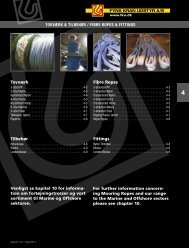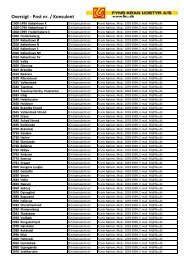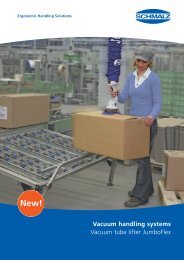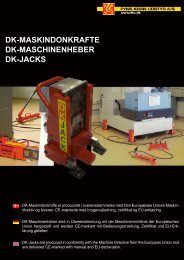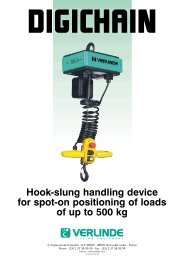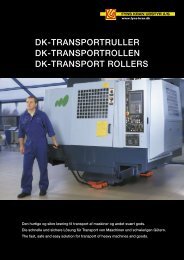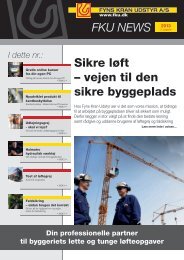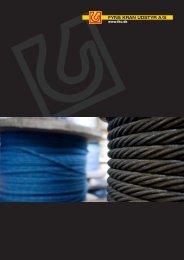Hent pdf-fil - Fyns Kran Udstyr A/S
Hent pdf-fil - Fyns Kran Udstyr A/S
Hent pdf-fil - Fyns Kran Udstyr A/S
Create successful ePaper yourself
Turn your PDF publications into a flip-book with our unique Google optimized e-Paper software.
www.fku.dk<br />
12-30 UDDANNELSE & TEKNISK INFORMATION / EDUCATION & TECHNICAL INFORMATION<br />
For strækning<br />
Ved forstrækning belastes ståltovet indtil flere gange med ca.<br />
45% af ståltovets nominelle brudstyrke, hvorved ståltovets<br />
sætningsforlængelse fjernes.<br />
Fjernelsen af sætningsforlængelse forudsætter, at ståltovet ikke<br />
yderligere håndteres. Ved yderligere håndtering falder wiren mere<br />
eller mindre tilbage til dens oprindelige form, men forstrækning<br />
er i mange tilfælde alligevel en god ting, idet ståltovet væsentlig<br />
hurtigere stopper sin sætningsforlængelse. Dette medfører, at<br />
ståltovet ikke skal efterspændes så mange gange.<br />
Anvendelsestemperaturer<br />
Maksimum anvendelsestemperatur<br />
- Zinken på galvaniserede tråde smelter ved 419°C. Ved 300°C<br />
begynder zinken at blive blød.<br />
- En opvarmning selv på et relativt kort stykke af wiren til over<br />
300°C – samtidig med at opvarmningen sker et stykke inde<br />
i wiren – bevirker, at wiren kommer i ubalance og evt. låses.<br />
Tråd-/wirebrud opstår herefter hurtigere.<br />
- Trådenes mekaniske egenskaber, f.eks. brudstyrke og<br />
bøjestyrke, ændrer sig ved opvarmning. Opvarmning i f.eks. en<br />
time ved 200°C bevirker et fald i trådenes bøjestyrke.<br />
- Et kunstfiberhjerte begynder at blive blødt ved 80°C-100°C.<br />
Et blødt hjerte bevirker, at understøtningen for dugterne<br />
forsvinder og stålwiren kommer i ubalance. Tråd-/wirebrud vil<br />
hurtigere forekomme.<br />
- Sisalhjerter kan tåle væsentligt højere temperaturer end<br />
ståltov med kunstfiberhjerte.<br />
Da brudstyrke og bøjelighed/fleksibilitet ofte er vigtige<br />
mekaniske egenskaber for et ståltov, kan <strong>Fyns</strong> <strong>Kran</strong> <strong>Udstyr</strong> A/S<br />
ikke anbefale, at:<br />
- Ståltov med stålhjerte opvarmes til over 200°C gennem<br />
længere tid.<br />
- Ståltov med sisalhjerte opvarmes til over 200°C gennem<br />
længere tid.<br />
- Ståltov med kunstfiberhjerte opvarmes til over 75°C gennem<br />
længere tid.<br />
Overfladetemperaturen kan i en kort periode accepteres at stige<br />
til 400°C.<br />
Pre-stretching<br />
By pre-stretching, the steel wire rope is loaded to approx. 45%<br />
of its nominal tensile strength, during the course of which<br />
the steel wire rope’s construction elongation is removed. The<br />
removal of the construction elongation supposes that the steel<br />
wire rope is not subjected to further treatment! If there is<br />
further treatment, the steel wire rope will more or less return<br />
to its original form. However, pre-stretching is in many cases<br />
a good idea, because it means that the steel wire rope more<br />
rapidly ceases its constructional elongation. However, in many<br />
instances pre-stretching can still be beneficial, as the steel wire<br />
rope’s constructional elongation will thus be completed much<br />
more quickly. This in turn means that the steel wire rope does<br />
not need to be re-tightened many times.<br />
Operating Temperatures<br />
Maximum Operating Temperature<br />
- Zinc on galvanised wires melts at 419°C. At 300°C the zinc<br />
begins to soften.<br />
- If a relatively short piece of cable is heated to more than<br />
300°C, the heating affects the inside of the wire rope, the<br />
wire rope will become unbalanced and may become locked,<br />
causing fractures in the cable/wires to occur more quickly.<br />
- The wires’ mechanical properties, e.g. tensile strength and<br />
bending strength, change when the temperature rises. A<br />
temperature of e.g. 200°C for 1 hour will reduce the wires’<br />
bending strength.<br />
- An artificial fibre core starts to soften at 80-100° C. A soft<br />
core means that the support for the strands disappears and<br />
the steel wire rope will become unbalanced, causing fractures<br />
in the cable/wires to occur more quickly.<br />
- Sisal cores can tolerate significantly higher temperatures than<br />
steel wire rope with artificial fibre cores.<br />
Since tensile strength and pliability/flexibility are often important<br />
mechanical properties for a steel wire rope, <strong>Fyns</strong> <strong>Kran</strong> <strong>Udstyr</strong><br />
A/S does not recommend that a steel wire rope with:<br />
- A steel core is subjected to temperatures above 200°C<br />
for a longer period of time.<br />
- A sisal core is subjected to temperatures above 200°C<br />
for a longer period of time.<br />
- An artificial fibre core is subjected to temperatures above<br />
75°C for a longer period of time.<br />
For a short period of time it can be acceptable for the surface<br />
temperature to reach 400°C.<br />
12<br />
Odense | Vallensbæk | Esbjerg | Aalborg<br />
+45 7015 2015 | fku@fku.dk<br />
Version 7.0 - Maj 2013



